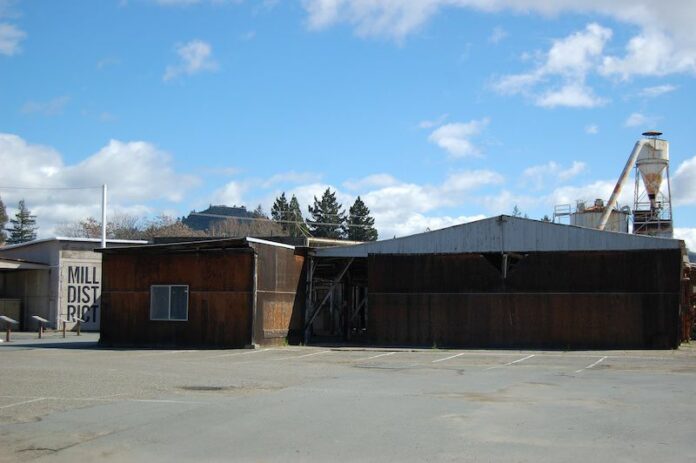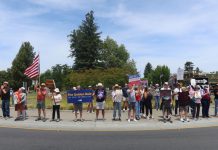One vote down, 12 years to build.
Healdsburg City Council unanimously passed the first reading of an ordinance approving the development agreement between developer Replay and the city for a 208-unit project in the Mill District.
“This is a momentous moment for Healdsburg,” Mayor David Hagele said. Hagele noted the difficulty of residents finding a place that’s affordable and how many income restricted units the plan adds using local preference language.
“That’s action,” he said with noticeable emotion. “To me that’s a big deal.”
Development agreements must be agreed upon by both parties and the city’s vote came after caucusing with Replay briefly to ensure changes made were still OK moving ahead.
The project will include 70 units that cover the “missing middle” and low and very low income affordable housing units.
Forty units are broken down in low and very low income units — 24 to very low and 16 to low. These will range from a studio to a three-bedroom unit. They will start being built in the project’s first phase.
The 30 “missing middle” units are for middle-income buyers or renters making 120 to 160 percent annual median income. One of the changes made to the development agreement was to take the eight non-deed restricted middle income units and restrict them alongside the rest of the 22 units if they were to be put up for sale. These eight units were created as “affordable by design,” which City Manager David Mickaelian explained.
The idea behind affordable by design was to have low-square-foot units with easy access to amenities that would naturally go for a lower open market rate when the units were sold after the initial purchase. The design concepts will not change with the potential deed restricted properties.
Councilmember Joe Naujokas was in favor of keeping the units as is, saying that they were an experiment to see what affordable housing the market could support.
The concern was that after the initial sale, demand would be such that prices for these eight units would quickly scale up to an unaffordable rate for people making up to 160 percent of the annual median income. Though the first sale would be to an income restricted buyer, price would be determined by market value, and only by market value for every sale after that.
The agreement will now also put more of the obligation to purchase a new fire truck, which was a previous part of the agreement, on Replay, covering the gap between the cost of the vehicle and current funding sources, around $245,000.
Other contributions from both parties will remain unchanged. Replay will put up $1.3 million for connectivity, which will mainly address getting around or over the railroad tracks.
The city will contribute $250,000 to the project in order to assist Replay with tax credit applications. This “skin in the game” from the city helps show creditors commitment from the city and that Replay is working in conjunction with the community.
In turn, the city will receive $250,000 from Replay for homelessness and transitional housing programs.
The tentative map for the project was also approved unanimously. The map includes roads accessed by Healdsburg Avenue with parking on roadsides.
One of the changes made during the meeting was an update to how roadside parking, sidewalks and shade trees interacted. The trees will have paved areas between the trees, which are spaced 30 feet apart. Sidewalk width changed slightly but continuous roadside parking remains.
The map also contains seven main lots that include a 53-room hotel and 15,000 square feet of commercial space that will go along Healdsburg Avenue. The project will be split between four building cycles, which occur every three years. Thus, a 12-year plan is now being moved ahead on by Replay.
“All of this is because of the Growth Management Ordinance,” Councimember Shaun McCaffery said of the time and deliberation the project has undertaken and will undergo.
David Hill, speaking for Replay, said the developer had looked at its impact on the ordinance and noted that since 2001, the city has issued roughly half of its possible building permits, which allows for the project to take around 40 allocations per year, which can possibly lead to permits issued.
A total of 90 permits per three years is allowed under the ordinance.
Mickaelian said that this project would take up most if not all of the city’s permits of this scale for the next several years, and limits what other projects can move forward until the Mill District is complete, estimated around 2031.
“This is but one step in this project going forward,” Hill said during his presentation, noting that there will be many meetings at the Planning Commission and before council as buildings are finalized and construction moves ahead.
Public comment for the project was mostly positive. Supporters said that the Replay office on Center Street was welcoming of ideas and had an open door policy.
Consideration had been made for several representatives of other parts of the community, including those working with the homeless and the project’s direct neighbors.
It was also noted that the project had done well with its inclusionary housing, especially since affordable and middle-income needs weren’t top concerns for some when the project first set out.
Those against it warned mainly of gentrification and cautioned that wording of the agreement may not be strict enough.
Before voting for the agreement, Vice Mayor Leah Gold said the site was a missed opportunity, and that going forward, she said the city should do better. She wanted to be able to outright buy a site such as the Mill District in order to have greater control on density and affordable units. She also noted that the hotel included goes against what she saw in public opinion on building new hotels.
On future projects, Naujokas said that the zoning laws in the city needs revisiting.
Councilmember Evelyn Mitchell, who noted that she was not on council at the start of the project, said that she is excited to see what kind of affordable options will be presented.
While questioning Hill about the project, it was pointed out that aesthetic building materials would be the same or similar between the market rate housing and affordable housing to create a more seamless community.
The council will next vote on the second reading of the development agreement ordinance at its next regular meeting on Monday, March 18.









